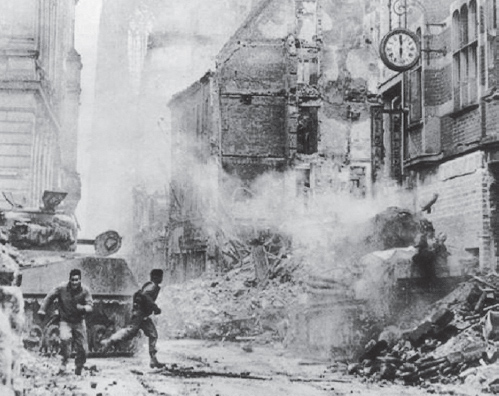

| GORDON L ROTTMAN | ILLUSTRATED BY PETER DENNIS |
Consultant editor Martin Windrow
The armored division  Combat commands
Combat commands  Armored infantry regiments and battalions
Armored infantry regiments and battalions
Companies – platoons – squads
Individual weapons – crew-served weapons  The halftrack
The halftrack
Lack of doctrine  Lack of training
Lack of training  Movement formations
Movement formations  The squad and platoon: life in the halftrack – dismounted formations – Mission capabilities: the rifle company – the armored infantry battalion – the armored infantry regiment
The squad and platoon: life in the halftrack – dismounted formations – Mission capabilities: the rifle company – the armored infantry battalion – the armored infantry regiment  Fire support
Fire support
Understanding and exploiting the balance of strengths and weaknesses  Communications
Communications
Failure and success: CCA, 12th Armored Division, January-February 1945 – dismounted company action without armor – tank–infantry team clearing a town
In the years following the moderately effective appearance of tanks on the battlefields of the Great War there was a great deal of debate in regards their future roles and employment, giving rise to two basic schools of thought on armor tactics. One saw tanks only as slow-moving gun platforms providing direct support to the infantry: in effect, simply machine gun-destroyers and obstacle-breachers. The more dynamic school envisioned highly mobile independent attack forces with their own artillery, engineers, logistical support, and (oh, yes...) some infantry. Armor was the cavalry’s replacement, intended to slice through enemy lines and strike deep in the rear to destroy and disrupt command posts, reserves, artillery, and logistics. In reality, both capabilities are necessary – tanks supporting infantry, and independent combined-arms armor forces – but regardless of the tanks’ role, infantry is a critical necessity for the successful employment of armor, as are all other arms and services.
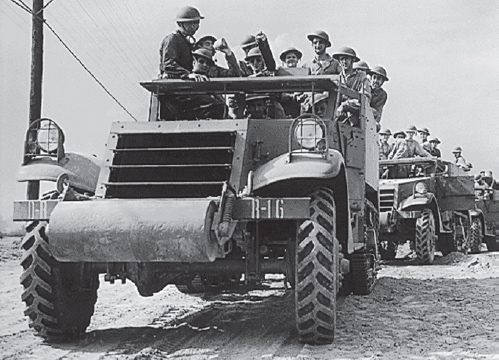
Pre-war M3 halftracks of a rifle platoon line up for maneuvers. Bumper markings were not standardized at this time, but were usually yellow; these vehicles belongs to the 7th Cavalry Brigade (Mechanized). A .30cal M1917A1 water-cooled machine gun can be seen pointing skyward on the lead halftrack.
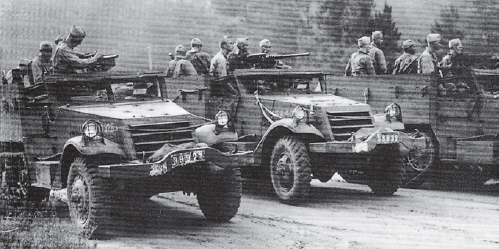
Three pre-war M3 halftracks with winches in place of the bumper-mounted roller. Typically only the company maintenance section had a halftrack with a winch, but in practice they were issued irregularly and any number might be found in a unit. All three vehicles mount .50cal M2 machine guns.
Most armor-force prophets accepted the need for some infantry, but the question was how to transport them, and how exactly should they be employed? For the most part these visionaries seriously underestimated the ratio of infantry necessary to support tanks. Tankers viewed infantry just as infantrymen viewed tanks – as essentially a support for their own arm – and the necessity for the complete integration of units of all branches for effective combined-arms operations was far from understood.
* * *
The integration of infantry and armor had a slow start. The first such effort was in 1929 when Company H, 34th Infantry was motorized with 1½-ton six-wheel trucks and was made part of the fledgling Mechanized Force, a hodge-podge of small tank, armored car, artillery, and support units. This “Gasoline Brigade” did not “belong” to a particular branch; an effort was made to place it in the cavalry, since it was viewed as an extension of the cavalry’s mobility and shock power, though many felt that the resulting branch jealousies would be counterproductive to the Force’s development. Regardless, Army Chief of Staff Gen Douglas MacArthur disbanded the Force and turned its assets over to the cavalry, with the infantry company, engineers, and artillery reverting to their own branches’ control. A new unit was created in 1933, 1st Cavalry Regiment (Mechanized); this was not a combined-arms unit, but purely cavalry. In the meantime the infantry demanded its own tank capability simply as support for infantrymen on foot; the Infantry Tank School had been created, and the existing 1st Tank Regt became the 66th Infantry Regt (Light Tank).
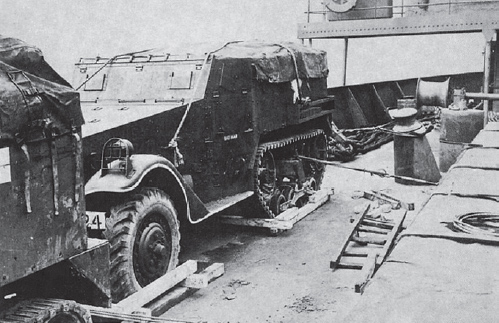
An M3 halftrack secured by rope and chocked in place aboard a transport for overseas movement. The canvas top cover is in place, but without the bows that would raise it about a foot higher.
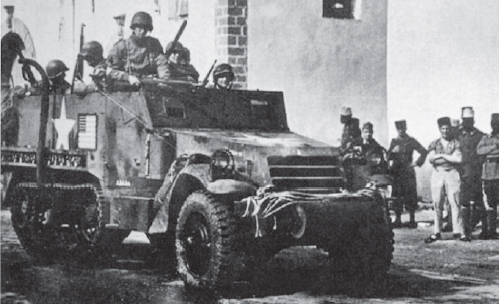
An M3 halftrack rolls through an Algerian town. The American flag adorned the sides of halftracks in North Africa as a means of friend-or-foe recognition.
In 1938 the 7th Cavalry Brigade (Mechanized) was activated, with the 1st and 13th Cavalry Regts; this relied on combat cars (light tanks) and armored cars for combat power, with some artillery but no infantry. In 1940 the infantry consolidated its tanks into the Provisional Tank Bde, strictly a holding unit for tanks. During that year’s Louisiana Maneuvers the two brigades were formed into an ad hoc tank division; the value of these units was recognized, and after the success of the German Panzers in Europe it was realized that combined-arms armored divisions were essential, with halftrack-borne infantry assigned to the new formations. The 7th Cavalry Bde became the 1st Armored Division, and the Provisional Tank Bde the 2d Armd Div on July 15, 1940. The arrival of equipment was sluggish while America slowly geared up for war.
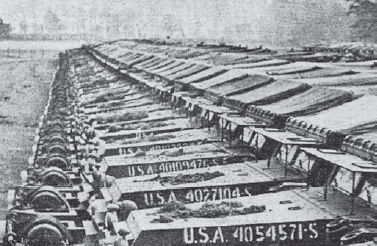
Rows of M3 halftracks stored in Britain and waiting issue to deploying units. All have bumper winches. Note the soil spread on the white star marking on the hood, to make it less noticeable to aircraft.
In 1941–42 the Army planned to organize five motorized infantry divisions; each would be fielded alongside two armored divisions, the three comprising an armored corps. They were to be organized along the lines of a standard infantry division, but the infantry regiments would be provided sufficient trucks to make them completely mobile. There would also be significantly increased maintenance assets, and a reconnaissance squadron rather than a troop. The original test division – 4th Inf Div – was partly equipped with halftracks, but these were withdrawn. The 6th–8th and 90th Inf Divs were also reorganized as motorized, but did not receive additional trucks. In early 1943 these divisions were converted back to standard infantry; they required too many vehicles and too much shipping space, fuel, and tires. The 4th Mot Div was to be “armorized,” with halftrack-equipped armored infantry regiments and full-tracked self-propelled artillery. The 4th required more shipping space than an armored division; rejected by theater commanders, it was converted to standard infantry.
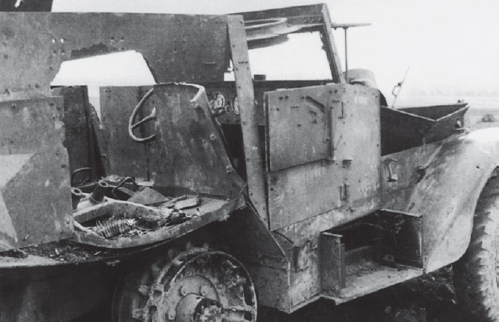
The effects of antitank gun fire on an M2 halftrack car; the contents of the ammunition storage compartment had detonated and caused the entire vehicle to burn. The 3.7cm Pak 35/36 AT gun –nicknamed the Türklopfer (Doorknocker) by German soldiers, as it was ineffective against most tanks – was still deadly to lightly armored American halftracks.
The Armored Force was established on July 10, 1940 at Ft Knox, Kentucky to conduct service tests for armored units and oversee their organization and training. It was redesignated the Armored Command on July 2, 1943, with a lessening of its control of the armored divisions, and at the same time the armored corps were redesignated army corps.1 It was redesignated yet again, as the Armored Center, on February 20, 1944, becoming essentially a replacement training organization. Even though armored infantry units were components of armored divisions, most of their tables of organization, doctrine, organization, and training standards were the responsibility of the Chief of Infantry at Ft Benning, Georgia.
The fighting in North Africa in early 1943 identified many flaws in armor doctrine, tactics, organization, and equipment. The US Army suffered greatly from branch parochialism, and the cost of such self-centeredness was learned the hard way in combat; in the early days the situation actually worsened, and co-operation between armor and infantry was extremely poor. Separate tank battalions supported infantry divisions, but often infantry commanders did not include tank unit officers in their staff meetings. Even the units of the 1st Armd Div were frittered away in support of infantry. Far from combat welding them into a team, the distrust between tankers and infantrymen actually intensified. Fortunately, many of these issues had been resolved by the time of the invasion of continental Europe in mid 1944, with the recognition of the need for increased tank–infantry training and coordination.
Only the 1st and 2d Armd Divs fought in North Africa; the 1st went on to fight in Italy and the 2d on Sicily and then in Northwest Europe. All other armored divisions (3d–14th, 16th, 20th) served in Northwest and Central Europe. (The 16th and 20th saw only one and two weeks’ combat, respectively, in the war’s final days.)
* * *
This study is devoted to the armored infantry battalions and regiments organic to armored divisions and supplying their infantry component. They were not simply standard infantry units riding halftracks, but were uniquely organized, armed, and equipped. The actions of armored divisions are much studied, but often the tanks are highlighted at the expense of the armored infantry that provided half of the divisions’ maneuver battalions. One reason for this inequity is that the armored infantry seldom fought from their halftracks, most often fighting on foot alongside Sherman tanks.
1 Armored corps were redesignated standard army corps on October 10, 1943 before deploying overseas: II Armd Corps became XVIII Corps, III became XIX Corps, and IV became XX Corps. I Armd Corps was inactivated in Tunisia and its assets became Seventh Army on July 10, 1943. The Army planned for 61 armored divisions in 1941, reduced this to 47 along with 23 armor corps in 1942, then to 26, then 20. In practice only 16 armored divisions were organized.
The 1940 armored division, which never saw combat, was a tank-heavy force with a cumbersome command arrangement. It consisted of an armored brigade with one two-battalion medium and two three-battalion light armored regiments, and a battalion-sized artillery “regiment” with only 24 howitzers instead of 36. A two-battalion “infantry regiment (armored)” was assigned to the division, seemingly almost as an afterthought. There was also a three-battery artillery battalion to support the infantry regiment, but with only four truck-drawn 105mm howitzers per battery plus a battery of eight 75mm antitank guns. Divisional units included engineer, ordnance maintenance, quartermaster supply, and medical battalions; a signal company; and a battalion-sized reconnaissance squadron with a light tank, an armored rifle, and two reconnaissance companies. The division possessed 381 tanks, 148 halftracks, and 97 scout cars, with 12,697 troops.
This ratio of only two infantry battalions to eight of tanks was entirely inadequate. Counting assets in the reconnaissance squadron, there were 25 tank companies (six medium, 19 light) to only seven rifle companies. The division could not secure the ground it took, provide flank and rear security, mop up, and prepare the ground for defense, much less hold it. Only the 1st and 2d Armd Divs were organized under this excessively unbalanced structure.
In March 1942 the armored division was streamlined to improve command and control and increase the ratio of infantry to tanks. The burdensome brigade echelon was eliminated, along with one armored regiment; there were now two armored regiments, each with one light and two medium battalions. The armored infantry regiment was expanded to three battalions, and there were now three armored field artillery (AFA) battalions, each with three six-tube self-propelled 105mm howitzer batteries. Command and control elements were part of the division headquarters: division headquarters, armored signal and service companies, headquarters of the division artillery command, and two small combat command headquarters and headquarters detachments. The two CCs could control any mix of tank, armored infantry, and armored artillery units plus other supporting elements.
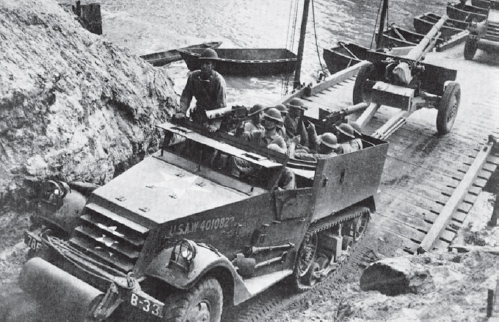
During the Louisiana Maneuvers, an M2 halftrack car of 78th Field Artillery Bn comes off a pontoon bridge. Mainly used as a prime-mover, this one tows a 75mm M1897A2 field gun, which was the standard divisional artillery piece until it began to be replaced by the 105mm M2A1 howitzer in 1940. The 78th FA Bn later became an armored field artillery (AFA) battalion of the 2d Armored Division.
While the ratio of infantry to armor had improved it was still not enough. There were now 19 tank companies (12 medium, seven light) and nine armored rifle companies. There were 390 tanks (an increase), 694 halftracks, 40 scout cars, and 14,630 men. Reconnaissance capabilities had been improved; the reconnaissance battalion now had three companies plus one of light tanks, having lost its rifle company, and each armored regiment now had a reconnaissance company.
Further improvements were implemented in September 1943. (The new organization was much influenced by the new Panzer division, with its streaM1ined command and control and utilization of smaller mission-oriented task forces; the British were also using smaller, more controllable armored divisions.) The revisions reduced the division’s strength by almost 4,000 troops to 10,937, with 263 tanks, 501 halftracks, and 54 armored cars. Divisions in the States reorganized between September and November 1943. The overseas 1st, 2d, and 3d Armd Divs retained the 1942 structure of one armored infantry and two tank regiments; they were referred to as “heavy” divisions and the others as “light.” The 1st was converted to a light division in Italy in June-July 1944. The 2d and 3d retained the heavy structure through the war; the Commanding General, European Theater of Operations, a proponent of the old heavy structure, declared that there was no time to reorganize the divisions due to ongoing operations.
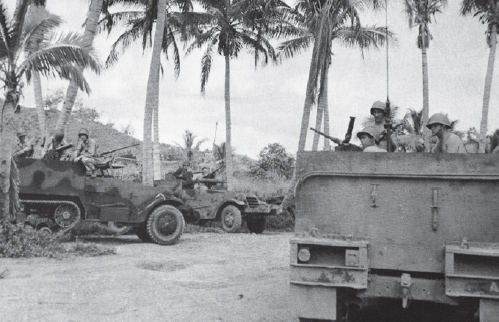
M3 halftracks of 6th Armd Inf Regt, 1st Armd Div halt in a desert oasis in Tunisia; note the brown-on-olive drab camouflage pattern. The 6th AIR was the first armored infantry unit to see action.
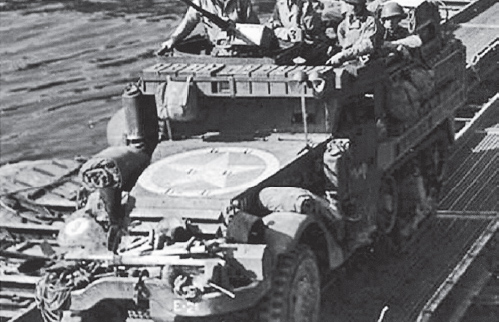
This unit has added a rack over the windshield for l0x .50cal ammunition cans. Note the musette bag slung on the rack. Since the bumper number shows that this M3A1 belongs to Company E, it is assigned to the 2d Bn of either 36th or 41st AIR, in 3d or 2d Armd Div, respectively.
3